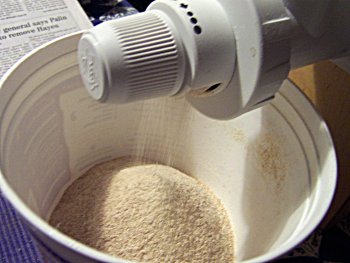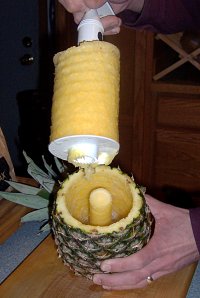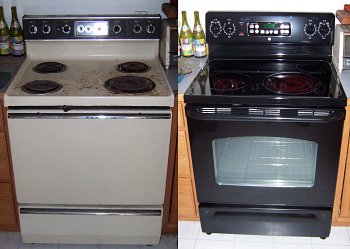Someone on Metafilter wanted to know if anyone had a recipe for a good whole grain cereal to make with a grain grinder. I didn't want to fork over $5 to help them out, so I'll post this and hope they happen across it. As I've mentioned in the past, I have a Family Grain Mill. After a few months of using it I've decided it's an OK mill, but awfully slow because it takes two passes to make acceptable flour, and it seems a bit flimsy to me. I doubt it's going to outlive me like a Country Living mill will.
Anyway, I've been refining my cereal recipe for the past couple months, and the best recipe so far is 2 parts oat groats, 2 parts wheat, 2 parts yellow corn (maize), 2 parts rice (I'm using Jasmine, but a cheaper long grain rice would probably be just as good), 1 part rye, and one part amaranth (quinoa would also work). Everything except the amaranth is run through the grinder to produce a fairly fine meal. I set my mill on 2, but you will need to experiment with your mill and your preferences. After grinding, add the amaranth and mix. The amaranth (or quinoa) is added to complete the set of amino acids, especially lysine, which is in a low concentration in the other grains. The rye is probably not necessary, but the other ingredients add good flavors and textures that I think are important.
To make my morning breakfast I mix 1/3 cup of grains with 1 1/2 cups of water and bring to a boil. Remove from the heat, cover, and let it sit overnight. In the morning I add a bit of butter and heat it back up again. On our new stove I have to be pretty careful to quickly lower the heat so I don't cook it to the bottom of the pot in the morning. Once it's hot, pour on a bit of milk and some bananas, sugar, maple syrup or honey and eat. I've also made it from start to finish in the morning, but it's a lot harder to cook it long enough without it burning onto the bottom of the pot. The overnight method is very easy, quick, and it always works.
When you make food yourself like this, it's hard to tell what nutrients will be in it because the nutrition data in the USDA database are for uncooked grains, and they don't provide guidelines for what might be lost by cooking the grains. For what it's worth, my daily breakfast (1/3 cup of grain, 1/2 cup of milk, 1 tsp of sugar and 1 tsp of butter) adds up to:
| Nutrient | Value | 2,000 calorie diet |
| Calories | 1035 | 51% |
| Total Carb | 152 g | 50% |
| Protein | 35 g | 70% |
| Total Fat | 35 g | 49% |
| Fiber | 14 g | 58% |
There's also a surprising amount of the basic nutrients, but I don't have time to list them all. And without knowing how they're affected by cooking, I'm not sure how helpful it'd really be anyway.
Last weekend we decided to upgrade the coil elements on the stove that came with our house (the ugly yellow thing in the photo). We went to the Borg, looked at the replacement options and decided we'd better make sure we knew what sort of elements we had before buying anything. We tried to look up our stove at GE's website, but our model number didn't show up. I took apart one of the burners to see what the element looked like (pre-1992, hinged) and we went back, this time to Lowe's (they're across the street from one another, if you can believe it). Nothing matched. So we drove across the street to Home Depot. Nothing matched. Tired of trying to figure it out, and in keeping with the 21st century culture of consumerism, we gave up and decided to buy a new range.
It's one of those fancy electrics with the ceramic-glass top and large elements that can be set to more than one size to fit the cookware you're using. The one we chose has two single-size 7 inch burners in the back, one large 12 / 9 inch burner in the front, and next to it, a 10 / 6 inch burner. Lots of variety, and more importantly, two large burners up front. With our previous stove, it was impossible to cook an omelette and bacon at the same time, and even on the largest burner on the old stove (8 inch), I had to move the bacon around continually to keep it in the hot zone at the middle of my twelve inch cast iron pan.
This weekend was my first attempt at cooking bacon and eggs at the same time. I cooked bacon on the large burner in my large pan, and the burner heated the entire surface of the pan to the same temperature. No more hot spot in the middle, and the improved output and coverage resulted in perfect bacon. Without all the movement and cold spots, it cooked in half the time as on our old stove. The lower image on the right shows the bacon cooking evenly, and an IR temperature reading from the edge of the pan. Best of all, I cooked an omelette on the other front burner in my smaller ten inch cast iron pan.
I haven't baked bread in it yet, so I don't know how the oven will compare to our old one, but I can't imagine it could be worse. The smaller elements that sit inside the larger coils on the two front burners are a little weaker than I'd like, and as a result, it takes longer to boil water in our kettle than on the old stove. And the elements aren't variable; they're either on or off, so they're always clicking on and off at lower temperature settings, which is a little strange. But all in all, I'm really liking it. Someday we'll get a dual fuel, gas cooktop and electric oven, but for now, I'm happy with what we've got.

milling whole wheat flour
Over the past few years I've been working on trying to lower the amount of processed, "industrial" food in my diet. I don't agree with all of Michel Pollan's arguments in his recent New York Times Magazine article (Unhappy meals), but I do think he's right that we'd be a much healthier society if processed foods didn't supply the majority of our calories. We might be getting all of the named nutrients through industrial fortification of nutrient-poor refined foods, but it makes sense to wonder if it wouldn't be better to be eating the unprocessed food that has all the nutrients (both named an unnamed) already built in.
Last week I got a grain mill, bought several sacks of organically grown whole grains (hard red spring wheat, rye, and oat groats; yellow corn on the way) and have been working them into my diet. Steel cut oats with a little rye and wheat cooked into porridge for breakfast, and whole flours baked into bread for lunch.
Why mill my own? Turns out that the oils in most whole grains spoil rapidly after milling (which is one reason why refined grains have become so popular with producers and retailers, and why refined food has to be fortified with nutrients lost during processing), so the whole flours, corn meal, and other grains you buy in the supermarket have probably already started getting rancid. Corn is especially prone to this because, according to The Laurel's Kitchen Bread Book, corn has been selectively bread to maximize oil production in the seed, which contributes to a much shorter shelf life when the whole grain is milled. Whole grains will last years if they don't get wet or infested with bugs. I can also get organically grown whole grains, and that's not always a choice at the supermarket.
I got a Family Grain Mill, which is an inexpensive, but efficient mill. It's mostly plastic, which means it probably won't last forever, but it does a nice job at milling grains to any size from practically whole all the way down to flour. Milling grain into flour takes two passes, one from whole grain to grits size (which raised the temperature of my grain from 59°F to 73°F) and a second pass to flour (raising the final flour to 84°F, which is perfect for forming a warm dough that the yeast can groove on).
Yesterday I baked my first 100% whole wheat bread using grain I milled into flour that same day. I didn't have any trouble getting a nice elastic dough, and the bread turned out nicely.
Every so often I get curious about nutrition and whether my diet is actually a healthy one. Over the years I've used a program called NUT, which is a really great console program that uses all the data from the USDA National Nutrient Database for Standard Reference. A couple days ago I downloaded the latest version and compiled it on my MacBook Pro. Thanks to the genius of writing simple, portable C code that builds with gcc, it compiled perfectly (not even a single warning) and I was off and running.
Unfortunately I was having a little trouble deleting the 26,642 gram (58+ pound) apple I accidentally entered for lunch today, and because I had the source code available, I discovered a buffer overflow error in the menu entry code. (A buffer overflow is sort of like when a form asks for your first name but only has room for six letters, and instead of stopping at C-h-r-i-s-t you continue to write the rest of your name into the following boxes not designed for your first name.) So I wrote to the author. An hour later, he wrote me back to thank me for finding the bug. Along the way he found a couple more, fixed them, and released a new version.
Timeline: Find a bug before dinner. Contact author. By the time I'm having my first beer, the program has already been fixed.
Try getting that kind of support from your commercial vendor.

On this week's America's Test Kitchen the gadget guy demonstrated a device that cores, peels, and slices pineapples. The Cooks Illustrated review says that using a knife and carving the pineapple manually does yield more fruit (31 vs. 24 ounces of a 64 ounce pineapple), but this gadget makes it incredibly simple. The whole process took less than five minutes, required virtually no skill, and I got a whole bunch of pineapple slices to eat for lunch. According to my nutrition software, a single slice or raw pineapple contains 79% of your daily value of vitamin C, 34% for Manganese, and 5% of your daily fiber. All for less than 2% of your daily calories!
Here in Fairbanks, pineapple isn't exactly cheap (I think it was around $1.90 / pound, which means it's almost $4.00 for a pound of usable fruit), but I think that eating real, fresh food, is worth the money, and adding an occasional pineapple to my diet is a good thing.


